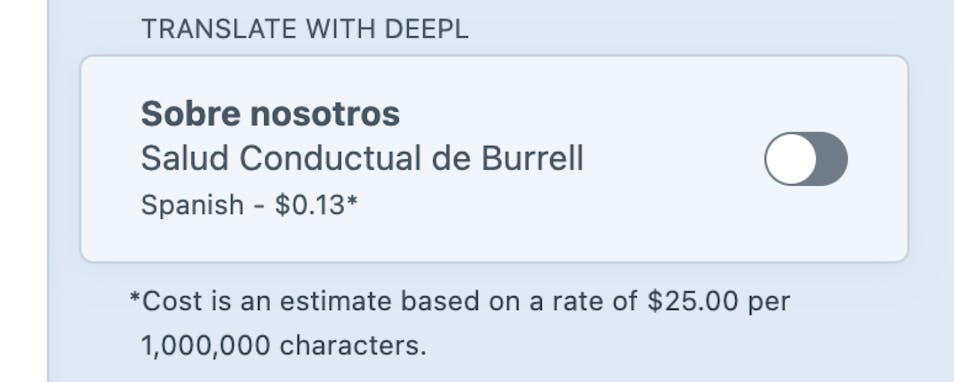


What is a multilingual website?
Perhaps you’ve heard terms such as “multi-language,” “multi-regional,” or “localized” mentioned when discussing website translations. We describe the solution we implement most often as a multilingual website:
- It is one website that serves users regardless of their geographic location.
- It offers essentially the same content translated into multiple languages.
- Users can select the language they prefer using a dropdown menu.
- And each page has a unique url in each language.
Typically the site’s top-level domain stays the same while the first segment of the url indicates the desired language, eg. example.com/en for English and example.com/es for Spanish. However, some sites prefer to use a country code extension with their top-level domain, eg. example.de for German.
How are multilingual sites better than the alternative?
It’s fair to ask why a company should pursue a multilingual website when there are free alternatives on the table. In our experience, a multilingual site offers a superior customer experience that’s well worth the investment because it prioritizes translation quality. But before we dig into the benefits of a multilingual site, let’s first look at the two main alternatives:



One of our clients evaluating translation services is a native Spanish speaker. She wrote an email to her husband in Spanish, then had DeepL translate it to English. When she got home, she asked if he found anything odd about her email and he said he didn’t. Other translation services didn’t come close in her view.

Three questions to ask before pursuing a multilingual website
The potential benefits and ROI for a multilingual website will be specific to your organization’s context, but these questions will help you think through whether it is right for you:
- Is there an immediate need for another translation?
- Will adding multiple languages create an opportunity for growth?
- Can we scale and maintain multiple translations?
1. Is there an immediate need for another translation?
You may already recognize a clear need for another language based on the insights you have into your current customer base. But you can also review your site’s analytics to see what language your visitor’s web browsers are using. Google Analytics provides this data, as you can see in the figure below. This view is showing Spanish language page visits for a site in the state of Missouri.

But beyond the data you find in your website statistics, we think you should also consider if your users have English set as their browser’s default but they would still prefer a different language if it was available. We offer quantitative and qualitative customer research services to determine what percent of your customers would fall into that category.
2. Will adding multiple languages create an opportunity for growth?
A multilingual site can offer growth in several ways.
- Increased customer engagement, as users interact with content on your site in their first language.
- Increased customer satisfaction because your site offers a superior, customer-centric experience compared to your competitors.
- Increased traffic from SEO, because your site now contains new urls and keywords in other languages. Visitors will enter your website from a search engine results page (SERP) with their desired language already selected. One case study showed a 30% increase in overall traffic after adding additional languages.
3. Can we scale and maintain the translations?
Clients want to understand the cost and time involved to keep a large site with multiple translations up to date, and rightly so. We believe the answer is a resounding, “Yes, you can scale multiple translations.”; and this is where the solution we have developed on Craft CMS has proven immensely valuable.
We developed a custom module that combines DeepL’s industry-leading automated translation with the opportunity for human author review.
-
Authors can choose to manually or automatically translate every piece of content on the site.
-
Automatic translation is controlled with a toggle switch.
-
The control panel provides a real-time cost estimate for automated translations based on the number of characters to be translated.
Authors can edit and lock the translation if they want to preserve it as is.


Multilingual websites are intuitive to manage within Craft CMS
Out of the box, Craft CMS offers multi sites and multiple site groups. You could add any number of Site Groups and multiple translations within a single group. For example:
- Site Group - Your Corporate Site
- Site - Your Corporate Site / English
- Site in Your Corporate Site / Spanish
- Site Group - Your Non-Profit Foundation
- Site - Your Non-Profit Foundation / English
- Site - Your Non-Profit Foundation / Spanish
- ….and so on
All the sites are editable from the same control panel, and Craft’s author experience is highly customizable, extensible, and granular:
- Content can be enabled and disabled on a per-site basis.
- Content can be automatically translated, manually translated, or both.
As a Craft CMS Enterprise partner, we talk often about how its features make author’s lives easier and save time. We’re proud to be part of an ecosystem that makes these elegant solutions possible.
